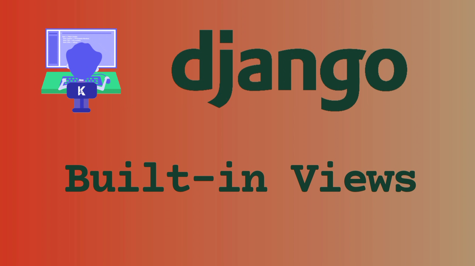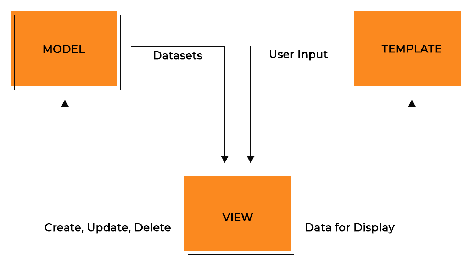Django is a popular Python web framework that allows developers to build robust, scalable, and maintainable web applications quickly. One of the critical components of Django is views, which are responsible for handling user requests and generating responses.
In Django, there are two types of views: Function-based views (FBVs) and Class-based views (CBVs). Both have their own advantages and disadvantages, and which one to choose depends on various factors, such as the complexity of the application, the size of the development team, and personal preferences.
In this article, we will compare Django's views and function-based views in detail and discuss the pros and cons of each approach. We will also provide examples of how to implement each type of view and when to use them.
Django Views
Django views are functions that take a web request and return an HTTP response. The views are responsible for handling user requests, interacting with the model layer, and generating responses that are sent back to the client.
Here is an example of a simple Django view:
from django.http import HttpResponse
def home(request):
return HttpResponse("Welcome to my website!")
This view takes a request object as input and returns an HTTP response object. The response object contains the content that will be displayed in the user's browser.
Pros of Django Views
1. Lightweight: Django views are lightweight and easy to understand. They are simple functions that take a request object and return an HTTP response. This simplicity makes it easy for developers to build and maintain web applications.
2. Better Performance: Since Django views are lightweight, they execute quickly, resulting in better performance. This is especially important when building high-traffic web applications.
3. Flexibility: Django views are flexible, and developers can customize them to suit their specific needs. Developers can also create reusable views that can be used across multiple applications.
Cons of Django Views
1. Code Repetition: Django views can lead to code repetition, especially when building complex web applications. Developers may find themselves writing similar code in multiple views, resulting in code bloat.
2. Steep Learning Curve: Django views can have a steep learning curve, especially for developers new to the framework. The framework has a lot of concepts and functions that developers need to learn before they can start building web applications.
Function-Based Views (FBVs)
Function-based views are a type of Django view that are implemented as functions. Like Django views, FBVs take a request object and return an HTTP response. However, they are implemented as simple Python functions.
Here is an example of an FBV:
from django.http import HttpResponse
def home(request):
return HttpResponse("Welcome to my website!")
Pros of FBVs
1. Simple: FBVs are simple and easy to understand. They are just Python functions that take a request object and return an HTTP response.
2. Reusability: FBVs can be easily reused across multiple applications. Developers can write a function that performs a specific task and use it in multiple views.
3. Easy to Test: FBVs are easy to test since they are just Python functions. Developers can write unit tests to test the function's behavior and ensure that it works as expected.
Cons of FBVs
1. Code Repetition: FBVs can lead to code repetition, especially when building complex web applications. Developers may find themselves writing similar code in multiple views, resulting in code bloat.
2. Limited Flexibility: FBVs are limited in terms of flexibility compared to CBVs. They don't have the same level of abstraction as CBVs and can't be easily extended to perform more complex tasks.
3. Code Maintainability: FBVs can be difficult to maintain, especially when the codebase grows. As the number of views and their complexity increases, it can become challenging to keep track of all the functions and ensure that they are working as expected.
Class-Based Views (CBVs)
Class-based views are a type of Django view that are implemented as classes. CBVs provide a higher level of abstraction than FBVs and allow developers to write reusable code that can be easily extended to perform more complex tasks.
Here is an example of a simple CBV:
from django.views import View
from django.http import HttpResponse
class HomeView(View):
def get(self, request):
return HttpResponse("Welcome to my website!")
In this example, we define a class called HomeView that inherits from the View class. We then define a get method that returns an HTTP response object.
Pros of CBVs
1. Code Reusability: CBVs promote code reusability, which can lead to cleaner and more maintainable code. Developers can define a base class that contains common functionality and then inherit from that class to create more specific views.
2. Flexibility: CBVs are highly flexible and can be easily extended to perform more complex tasks. Since they are implemented as classes, developers can use object-oriented programming techniques to create more sophisticated views.
3. Code Maintainability: CBVs are easier to maintain than FBVs since they promote code reuse and abstraction. As the codebase grows, it is easier to keep track of the different views and ensure that they are working as expected.
Cons of CBVs
1. Complexity: CBVs can be more complex than FBVs, especially for developers new to the framework. They require a solid understanding of object-oriented programming concepts, which can take some time to master.
2. Performance: CBVs can be slower than FBVs since they involve more overhead. However, this performance difference is usually negligible in most web applications.
3. Steep Learning Curve: CBVs can have a steep learning curve, especially for developers new to object-oriented programming concepts.
Conclusion
In summary, both Django views and function-based views have their own advantages and disadvantages. Django views are lightweight and easy to understand, while FBVs are simple and easy to test. CBVs promote code reusability and abstraction but can be more complex and have a steeper learning curve.
When deciding which approach to use, developers should consider the complexity of the application, the size of the development team, and personal preferences. Simple web applications may benefit from Django views or FBVs, while more complex applications may benefit from CBVs.
Ultimately, the choice between Django views and FBVs comes down to personal preferences and the specific requirements of the project. By understanding the pros and cons of each approach, developers can make informed decisions and build robust, scalable, and maintainable web applications with Django.









